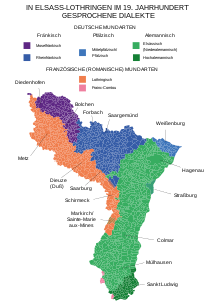German Lorraine
German Lorraine and German Lorraine referred to two things:
- the German-speaking area within Lorraine , as it existed into the 20th century;
- the district of Lorraine , that is the part of Lorraine that belonged to the realm of Alsace-Lorraine from 1871 to 1918 and thus to the German Empire .
Originally German-speaking Lorraine
The Germanic-Romanic (German-French) language border in Lorraine ran roughly along the line Sarrebourg (Saarburg) - Hayange (Hayingen) into the 20th century . More about their course in the article Lorraine (Franconian) . The Lorraine area northeast of this language border in today's Moselle and Bas-Rhin ( Crooked Alsace ) and in what is now Saarland was known as German-Lorraine. Nancy , the historic capital of Lorraine, and the ecclesiastical center of Metzboth are on the French side of the language border. The names of localities such as Audun-le-Tiche (Deutsch-Oth) and Audun-le-Roman (Welsch-Oth) or the names of the two source rivers of the Nied , the Nied Allemande (German Nied) and the Nied refer to the historical language border Française (French low), which lie on both sides of the language border and converge almost exactly on the language border.
The language border was also reflected in the administration early on. In the 13th century, the Duchy of Lorraine was subdivided into three Bellistuities (administrative and judicial districts, French bailliage ): the Bellistum Nancy ( bailliage de Nancy ), the Bellistum Vôge ( bailliage de Vôge ) and the German Bellistum ( bailliage d'Allemagne ) , the latter temporarily with the city of Wallerfangen in today's Saarland as the administrative seat. The Duchy of Lorraine became part of France in 1766. In 1790, at the time of the French Revolution , the old administrative structures were radically renewed. The motion of German-Lorraine MPs to set up their own German-Lorraine department did not find a majority in the Paris National Assembly . German Lorraine was incorporated into the Moselle and Meurthe departments, which were established in 1790 . Other German-speaking parts of historic Lorraine were in the Forêts department formed in 1795 and in the de la Sarre department established in 1798 . During the Second Peace of Paris in 1815, most of German Lorraine remained with France. The name referred to this area from then on.
Lorraine district as part of the German Empire 1871–1918
After the Franco-Prussian War , part of Lorraine was annexed to the newly founded German Empire in 1871 and formed the realm of Alsace-Lorraine with Alsace until 1918 . The Lorraine district, newly formed from parts of the two previous French departments of Meurthe and Moselle, included most of the historic German Lorraine as well as French-speaking areas west of the Franco-German language border around Metz and Château-Salins . This district of Lorraine with its capital, Metz, remained unchanged in its territorial form after the region was reintegrated into France in 1919 and forms the present-day Moselle department. During the German occupation 1940-1944 here consisting CdZ region Lorraine .
Web links
- Petition about bilingual teaching in primary schools, French and German, Strasbourg 1869, PDF, 4.2 MB
- Project Deuframat: German-French materials for history and geography lessons

